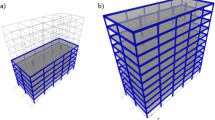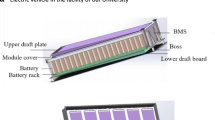Abstract
Nowadays the application of the sustainable resources (SERs) of the energy and significant role of the building sector due to environmental effects is notable. Therefore, finding the optimum combination of SERs is an important target to be noticed by the designers to achieve sustainable buildings. Regarding the energy consumption for local warm-water, electrical appliances, and to cool and heat the building space, a new method is suggested in this study to design the optimized combination of the sustainable energy systems to unify the building energy demand. Minimization of the two objectives including the initial energy request and the investment expense is considered as the multi-criteria optimization. Also, to find the expense-optimum solution, the universal expense has been studied. Furthermore, a limitation of achieving the SER combination’s minimum amount in line with the Albanian laws is regarded. The Grass Fibrous Root Optimization algorithm is applied as the optimization process using MATLAB® and DesignBuilder simulation software. Because the solutions should adhere to the lowest SER combination’s levels recommended through present regulations, a limitation is studied, too. A regular residential case of Tirana, in Albania, is chosen to be investigated by using the proposed methodology and regarding the present laws related to the efficiency of the energy. SER systems include heat pumps (HPs), PV panels, thermal solar energy systems. It has resulted that, the initial energy demand saves up to 29.5 kWh/m2 a and the universal expense up to 78,850 € as provided by the methodology comparing a building composition not considering the SERs. Aiming at sustainable development, the proposed methodology can be useful regarding two aspects including economic profits for the holders and the environmental advantages.





Similar content being viewed by others
Change history
06 March 2024
This article has been retracted. Please see the Retraction Notice for more detail: https://doi.org/10.1007/s12530-024-09577-6
References
Aghajani G, Ghadimi N (2018) Multi-objective energy management in a micro-grid. Energy Rep 4:218–225
Akbary P, Ghiasi M, Pourkheranjani MRR, Alipour H, Ghadimi N (2019) Extracting appropriate nodal marginal prices for all types of the committed reserve. Comput Econ 53(1):1–26
Akkar HA, Mahdi FR (2016) Grass root algorithm optimized neural networks for classification problem. Am Sci Res J Eng Technol Sci 26(4):90–100
Akkar HA, Mahdi FR (2017a) Grass fibrous root optimization algorithm. Int J Intell Syst Appl 11(6):15
Akkar HA, Mahdi FR (2017b) Adaptive path tracking mobile robot controller based on neural networks and novel grass-root optimization algorithm. Int J Intell Syst Appl 9(5):1
Alizadeh E, Barzegari M, Momenifar M, Ghadimi M, Saadat S (2016) Investigation of contact pressure distribution over the active area of PEM fuel cell stack. Int J Hydrog Energy 41(4):3062–3071
Aquino G et al (2020) Novel nonlinear hypothesis for the delta parallel robot modeling. IEEE Access 8:46324–46334
Arora S, Singh S (2019) Butterfly optimization algorithm: a novel approach for global optimization. Soft Comput 23(3):715–734
Ascione F, Bianco N, Mauro GM, Napolitano DF (2019a) Building envelope design: multi-objective optimization to minimize energy consumption, global cost, and thermal discomfort. Application to different Italian climatic zones. Energy 174:359–374
Ascione F, Bianco N, De Masi RF, Mastellone M, Vanoli GP (2019b) Phase change materials for reducing cooling energy demand and improving indoor comfort: a step-by-step retrofit of a mediterranean educational building. Energies 12(19):3661
Ashfahani A, Pratama M, Lughofer E, Ong Y-S (2020) DEVDAN: Deep evolving denoising autoencoder. Neurocomputing 390:297–314
Bekele G, Tadesse G (2012) Feasibility study of small Hydro/PV/Wind hybrid system for off-grid rural electrification in Ethiopia. Appl Energy 97:5–15
Brammya G, Praveena S, Ninu Preetha N, Ramya R, Rajakumar B, Binu D (2019) Deer hunting optimization algorithm: a new nature-inspired meta-heuristic paradigm. Comput J bxy133, https://doi.org/10.1093/comjnl/bxy133
Buildings DEotEPaotCoMotepo (2010) Off J Eur Union Legis 2010:13
Cao Y, Li Y, Zhang G, Jermsittiparsert K, Razmjooy N (2019a) Experimental modeling of PEM fuel cells using a new improved seagull optimization algorithm. Energy Rep 5:1616–1625
Cao Y, Wu Y, Fu L, Jermsittiparsert K, Razmjooy N (2019b) Multi-objective optimization of a PEMFC based CCHP system by meta-heuristics. Energy Rep 5:1551–1559
Çelik E (2020) A powerful variant of symbiotic organisms search algorithm for global optimization. Eng Appl Artif Intell 87:103294
Chiang H-S, Chen M-Y, Huang Y-J (2019) Wavelet-based EEG processing for epilepsy detection using fuzzy entropy and associative petri net. IEEE Access 7:103255–103262
Cuce E, Nachan Z, Cuce PM, Sher F, Neighbour GB (2019) Strategies for ideal indoor environments towards low/zero carbon buildings through a biomimetic approach. Int J Amb Energy 40(1):86–95
Daneshazarian R, Cuce E, Cuce PM, Sher F (2018) Concentrating photovoltaic thermal (CPVT) collectors and systems: theory, performance assessment, and applications. Renew Sustain Energy Rev 81:473–492
de Jesús Rubio J (2009) SOFMLS: online self-organizing fuzzy modified least-squares network. IEEE Trans Fuzzy Syst 17(6):1296–1309
Derhami S, Smith JS, Gue KR (2019) A simulation-based optimization approach to design optimal layouts for block stacking warehouses. Int J Prod Econ 223:107525
Dhiman G, Kumar V (2019) Seagull optimization algorithm: theory and its applications for large-scale industrial engineering problems. Knowl Based Syst 165:169–196
do Nascimento DA et al (2019) Sustainable adoption of connected vehicles in the Brazilian landscape: policies, technical specifications and challenges. Trans Environ Electr Eng 3(1):44–62
Elias I et al (2020) Hessian with mini-batches for electrical demand prediction. Appl Sci 10(6):2036
Fan X, Sun H, Yuan Z, Li Z, Shi R, Razmjooy N (2020) Multi-objective optimization for the proper selection of the best heat pump technology in a fuel cell-heat pump micro-CHP system. Energy Rep 6:325–335
Fei X, Xuejun R, Razmjooy N (2019) Optimal configuration and energy management for the combined solar chimney, solid oxide electrolysis, and fuel cell: a case study in Iran. Energy Sour Part A Recoveru Util Environ Effects 1–21
Gao W, Darvishan A, Toghani M, Mohammadi M, Abedinia O, Ghadimi N (2019) Different states of multi-block based forecast engine for price and load prediction. Int J Electr Power Energy Syst 104:423–435
Gil-Baez M, Barrios-Padura Á, Molina-Huelva M, Chacartegui R (2017) Natural ventilation systems in 21st-century for near zero energy school buildings. Energy 137:1186–1200
Gollou AR, Ghadimi N (2017) A new feature selection and hybrid forecast engine for day-ahead price forecasting of electricity markets. J Intell Fuzzy Syst 32(6):4031–4045
Gong W, Razmjooy N (2020) A new optimization algorithm based on OCM and PCM solution through energy reserve. In J Amb Energy 1–14
Gong X, Wu N, Li C, Liang M, Akashi Y (2019) Energy performance and CO2 emissions of fuel cells for residential application in Chinese hot summer and cold winter areas. IOP Conf Ser Earth Environ Sci 310(2):022057
Guo Y, Dai X, Jermsittiparsert K, Razmjooy N (2020) An optimal configuration for a battery and PEM fuel cell-based hybrid energy system using developed Krill herd optimization algorithm for locomotive application. Energy Rep 6:885–894
Hamian M, Darvishan A, Hosseinzadeh M, Lariche MJ, Ghadimi N, Nouri A (2018) A framework to expedite joint energy-reserve payment cost minimization using a custom-designed method based on mixed-integer genetic algorithm. Eng Appl Artif Intell 72:203–212
Hosseini Firouz M, Ghadimi N (2016) Optimal preventive maintenance policy for electric power distribution systems based on the fuzzy AHP methods. Complexity 21(6):70–88
Huang P, Huang G, Sun Y (2018) Uncertainty-based life-cycle analysis of near-zero energy buildings for performance improvements. Appl Energy 213:486–498
Kampelis N et al (2019) HVAC Optimization genetic algorithm for industrial near-zero-energy building demand response. Energies 12(11):2177
Leng H, Li X, Zhu J, Tang H, Zhang Z, Ghadimi N (2018) A new wind power prediction method based on ridgelet transforms, hybrid feature selection and closed-loop forecasting. Adv Eng Inform 36:20–30
Liu Y, Wang W, Ghadimi N (2017) Electricity load forecasting by an improved forecast engine for building level consumers. Energy 139:18–30
Lu Y, Wang S, Shan K (2015) Design optimization and optimal control of grid-connected and standalone nearly/net-zero energy buildings. Appl Energy 155:463–477
Meda-Campaña JA (2018) On the estimation and control of nonlinear systems with parametric uncertainties and noisy outputs. IEEE Access 6:31968–31973
Mehrjerdi H, Hemmati R (2020) Sustainable energy technologies and assessments
Monforti F, Gonzalez-Aparicio I (2017) Comparing the impact of uncertainties on technical and meteorological parameters in wind power time series modeling in the European Union. Appl Energy 206:439–450
Osman MM, Sevinc H (2019) Adaptation of climate-responsive building design strategies and resilience to climate change in the hot/arid region of Khartoum, Sudan. Sustain Cities Soc 47:101429
Pless S, Paul Torcellini P (2009) Getting to net zero. ASHRAE J 51(9):18
Rim C, Piao S, Li G, Pak U (2018) A niching chaos optimization algorithm for multimodal optimization. Soft Comput 22(2):621–633
Rosenow J, Cowart R, Bayer E, Fabbri M (2017) Assessing the European Union’s energy efficiency policy: will the winter package deliver on ‘Efficiency First’? Energy Res Soc Sci 26:72–79
Saeedi M, Moradi M, Hosseini M, Emamifar A, Ghadimi N (2019) Robust optimization based optimal chiller loading under cooling demand uncertainty. Appl Therm Eng 148:1081–1091
Sher F, Kawai A, Güleç F, Sadiq H (2019) Sustainable energy-saving alternatives in small buildings. Sustain Energy Technol Assess 32:92–99
Song M, Niu F, Mao N, Hu Y, Deng S (2018) Review on building energy performance improvement using phase change materials. Energy Build 158:776–793
Sun B et al (2020) Control strategies and economic analysis of an LTO battery energy storage system for AGC ancillary service. Energies 13(2):505
Tian M-W, Yan S-R, Han S-Z, Nojavan S, Jermsittiparsert K, Razmjooy N (2020) New optimal design for a hybrid solar chimney, solid oxide electrolysis and fuel cell based on improved deer hunting optimization algorithm. J Clean Prod 249:119414
Tizhoosh HR (2005) Opposition-based learning: a new scheme for machine intelligence. In: International conference on computational intelligence for modelling, control and automation and international conference on intelligent agents, web technologies and internet commerce (CIMCA-IAWTIC'06), vol 1, pp 695–701
Villarrubia M (2003) La Directiva 2002/91/CE relativa a la eficiencia energética de los edificios. Montajes e instalaciones: Revista técnica sobre la construcción e ingeniería de las instalaciones 33(371):72–80
Yang D, Li G, Cheng G (2007) On the efficiency of chaos optimization algorithms for global optimization. Chaos Solitons Fractals 34(4):1366–1375
Yazdani M, Jolai F (2016) Lion optimization algorithm (LOA): a nature-inspired metaheuristic algorithm. J Comput Design Eng 3(1):24–36
Acknowledgements
This work is partially supported by the Funding Project for Department of Education of Shaanxi Province in 2018 (No. 18JK0906); Natural Science and Technology Project Plan in Yulin of China (2016CXY-12), and Thanks for the help
Author information
Authors and Affiliations
Corresponding author
Additional information
Publisher's Note
Springer Nature remains neutral with regard to jurisdictional claims in published maps and institutional affiliations.
This article has been retracted. Please see the retraction notice for more detail:https://doi.org/10.1007/s12530-024-09577-6
Rights and permissions
Springer Nature or its licensor (e.g. a society or other partner) holds exclusive rights to this article under a publishing agreement with the author(s) or other rightsholder(s); author self-archiving of the accepted manuscript version of this article is solely governed by the terms of such publishing agreement and applicable law.
About this article
Cite this article
Li, X., Rodriguez, D. RETRACTED ARTICLE: Optimization of a building energy performance by a multi-objective optimization, using sustainable energy combinations. Evolving Systems 12, 949–963 (2021). https://doi.org/10.1007/s12530-020-09350-5
Received:
Accepted:
Published:
Issue Date:
DOI: https://doi.org/10.1007/s12530-020-09350-5




